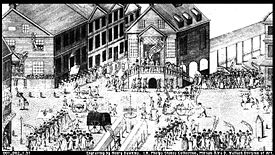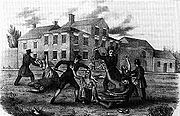
Paxton Boys
Encyclopedia

Vigilante
A vigilante is a private individual who legally or illegally punishes an alleged lawbreaker, or participates in a group which metes out extralegal punishment to an alleged lawbreaker....
group who murdered 20 Susquehannock
Susquehannock
The Susquehannock people were Iroquoian-speaking Native Americans who lived in areas adjacent to the Susquehanna River and its tributaries from the southern part of what is now New York, through Pennsylvania, to the mouth of the Susquehanna in Maryland at the north end of the Chesapeake Bay...
in events collectively called the Conestoga Massacre. Scots-Irish
Scots-Irish American
Scotch-Irish Americans are an estimated 250,000 Presbyterian and other Protestant dissenters from the Irish province of Ulster who immigrated to North America primarily during the colonial era and their descendants. Some scholars also include the 150,000 Ulster Protestants who immigrated to...
frontiersmen from central Pennsylvania
Pennsylvania
The Commonwealth of Pennsylvania is a U.S. state that is located in the Northeastern and Mid-Atlantic regions of the United States. The state borders Delaware and Maryland to the south, West Virginia to the southwest, Ohio to the west, New York and Ontario, Canada, to the north, and New Jersey to...
along the Susquehanna River formed a vigilante
Vigilante
A vigilante is a private individual who legally or illegally punishes an alleged lawbreaker, or participates in a group which metes out extralegal punishment to an alleged lawbreaker....
group to retaliate against local American Indian
Native Americans in the United States
Native Americans in the United States are the indigenous peoples in North America within the boundaries of the present-day continental United States, parts of Alaska, and the island state of Hawaii. They are composed of numerous, distinct tribes, states, and ethnic groups, many of which survive as...
s in the aftermath of the French and Indian War
French and Indian War
The French and Indian War is the common American name for the war between Great Britain and France in North America from 1754 to 1763. In 1756, the war erupted into the world-wide conflict known as the Seven Years' War and thus came to be regarded as the North American theater of that war...
and Pontiac's Rebellion
Pontiac's Rebellion
Pontiac's War, Pontiac's Conspiracy, or Pontiac's Rebellion was a war that was launched in 1763 by a loose confederation of elements of Native American tribes primarily from the Great Lakes region, the Illinois Country, and Ohio Country who were dissatisfied with British postwar policies in the...
.
Attack on Susquehannock

French and Indian War
The French and Indian War is the common American name for the war between Great Britain and France in North America from 1754 to 1763. In 1756, the war erupted into the world-wide conflict known as the Seven Years' War and thus came to be regarded as the North American theater of that war...
, the frontier of Pennsylvania remained unsettled. A new wave of Scots-Irish immigrants encroached on Native American land in the backcountry. These settlers claimed that Indians often raided their homes, killing men, women and children. One of the leaders of the settlers was the Reverend John Elder, who was the parson at Paxtang
Paxtang, Pennsylvania
Paxtang is a borough in Dauphin County, Pennsylvania, United States. The borough is a suburb of Harrisburg and is one of the earliest colonial settlements in South Central Pennsylvania.-History:...
and Derry
Derry Session House and Enclosure
Derry Session House and Enclosure is a historic site located on the grounds of Derry Presbyterian Church at Derry Township, Dauphin County, Pennsylvania. It consists of the log Session House, built about 1732, and a glass enclosure, erected in 1929. The hewn log Session House measures 18 feet by...
. He was known as the "Fighting Parson" and is widely believed to have kept his rifle in the pulpit while he delivered his sermons. Elder helped organize the settlers into a mounted military group and was named Captain of the group, known as the "Pextony boys."
In December 1763, a vigilante
Vigilante
A vigilante is a private individual who legally or illegally punishes an alleged lawbreaker, or participates in a group which metes out extralegal punishment to an alleged lawbreaker....
group made up of Scots-Irish frontiersmen, the Paxton Boys attacked the local Conestoga, a Susquehannock
Susquehannock
The Susquehannock people were Iroquoian-speaking Native Americans who lived in areas adjacent to the Susquehanna River and its tributaries from the southern part of what is now New York, through Pennsylvania, to the mouth of the Susquehanna in Maryland at the north end of the Chesapeake Bay...
tribe of descendants who had lived on land donated by William Penn to their ancestors in the 1690s. Many Conestoga were Christian, and they had lived peacefully with their European neighbors for decades. They lived by begging, bartering handicrafts, hunting, and from subsistence food given them by the Pennsylvania government.
Although there had been no Indian attacks in the area, the Paxton Boys claimed that the Conestoga secretly provided aid and intelligence to the hostiles. On December 14, 1763, more than fifty Paxton Boys marched on the Conestoga homes near Millersville, murdered six, and burned their cabins. The colonial government held an inquest and determined that the killings were murder. The new governor, John Penn
John Penn (governor)
John Penn was the last governor of colonial Pennsylvania, serving in that office from 1763 to 1771 and from 1773 to 1776...
offered a reward for their capture.
He placed the remaining sixteen Conestoga in protective custody in Lancaster, but the Paxton Boys broke in on December 27, 1763. They killed and scalped six adults and eight children, leaving two survivors. The attackers were never identified.
The Rev. Elder, who was not directly implicated in either attack, wrote to Governor Penn, on January 27, 1764:
March on Philadelphia
The Paxton Boys marched toward Philadelphia in January of 1764 with about 250 men. Benjamin Franklin led a group of civic leaders to meet them in GermantownGermantown, Philadelphia, Pennsylvania
Germantown is a neighborhood in the northwest section of the city of Philadelphia, Pennsylvania, United States, about 7–8 miles northwest from the center of the city...
and hear their grievances. After leaders agreed to read their pamphlet of issues before the colonial legislature, the mob of men agreed to disperse.
Many colonists were outraged about the killings in November of innocent Conestoga, describing the murders as more savage than those committed by Indians. Benjamin Franklin's "Narrative of the Late Massacres" concluded with noting that the Conestoga would have been safe among any other people on earth, no matter how primitive, except "'white savages' from Peckstang and Donegall!"
A leader of the Paxton Boys Lazarus Stewart
Lazarus Stewart
Captain Lazarus Stewart was an 18th century Pennsylvanian frontiersman and leader of the Paxton Boys. He achieved notoriety by leading the massacre of the Susquehannocks in 1763, and was a prominent military commander — on the Yankee side — in the Pennamite Wars...
was killed in Wyoming Massacre in 1778
In fiction
- Thomas PynchonThomas PynchonThomas Ruggles Pynchon, Jr. is an American novelist. For his most praised novel, Gravity's Rainbow, Pynchon received the National Book Award, and is regularly cited as a contender for the Nobel Prize in Literature...
includes the Paxton Boys and the Lancaster Massacre in his novel Mason & DixonMason & DixonMason & Dixon is a postmodernist novel by American author Thomas Pynchon published in 1997. It centers on the collaboration of the historical Charles Mason and Jeremiah Dixon in their astronomical and surveying exploits in Cape Colony, Saint Helena, Great Britain and along the Mason-Dixon line in...
(1997).
External links
- "A Narrative of the Late Massacres...", Benjamin Franklin's account of the massacre and criticism of the Paxton Boys

